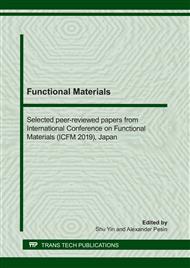[1]
KR. Rogers, Anal. Chim. Acta 568 (2006) 222–231.
Google Scholar
[2]
S. Rodriguez-mozaz, M-P. Marco, MJL. Alda, Pure Appl. Chem. 76 (2004) 723–752.
Google Scholar
[3]
S. Rodriguez-Mozaz, M-P. Marco, MJL. Alda, D. Barceló, Talanta 65 (2005) 291–297.
Google Scholar
[4]
M. Sharpe, J. Environ. Monit. 5 (2003) 109–113.
Google Scholar
[5]
P. Leonard, S. Hearty, J. Brennan, L. Dunne, J. Quinn, T. Chakraborty, R. O'Kennedy, Enzyme Microb. Technol. 32 (2003) 3–13.
Google Scholar
[6]
N. Verma, M. Singh, BioMetals. 18 (2005), 121–129.
Google Scholar
[7]
J. Homola, Chem. Rev. 108(2) (2008) 462–493.
Google Scholar
[8]
Y. Yanase, T. Hiragun, T. Yanase, T. Kawaguchi, K. Ishii, M. Hide, Allergology Int. 62 (2013) 163–169.
DOI: 10.2332/allergolint.12-ra-0505
Google Scholar
[9]
J. Mitchell, Sensors 10 (2010) 7323–7346.
Google Scholar
[10]
M. Farre, E. Martinez, J. Ramon, A. Navarro, J. Radjenovic, E. Mauriz, L. Lechuga, M.P. Marco, D. Barcelo, Anal. Bioanal. Chem. 388 (2007) 207–214.
Google Scholar
[11]
X. Lu, H. Zheng, X. Li, X. Yuan, H. Li, L. Deng, H. Zhang, W. Wang, G. Yang, M. Meng, R. Xi, HY. Aboul-Enein, Food Chem. 130 (2012) 1061–1065.
DOI: 10.1016/j.foodchem.2011.07.133
Google Scholar
[12]
M. Petz, Monatsh Chem. 140 (2009) 953–964.
Google Scholar
[13]
T. Kawaguchi, DR. Shankaran, SJ. Kim, K. Matsumoto, K. Toko, N. Miura, Sens. Actuators B Chem. 133 (2008) 467–472.
Google Scholar
[14]
A. Amine, H. Mohammadi, I. Bourais, G. Palleschi, Biosens. Bioelectron. 21 (2006) 1405–1423.
Google Scholar
[15]
H. Bai, R. Wang, B. Hargis, H. Lu, Y. Li, Sensors 12 (2012) 12506–12518.
Google Scholar
[16]
B. Bohunicky, SA. Mousa, Nanotech. Sci. Appl. 4 (2011) 1–10.
Google Scholar
[17]
WL. Shelver and DJ. Smith, J. Agric. Food Chem 52 (2004) 2159−2166.
Google Scholar
[18]
G. Fan, J. Huang, X. Fan, S. Xie, Z. Zheng, Q. Cheng, P. Wang, J. Mol. Liq. 169 (2012) 102–105.
Google Scholar
[19]
C-C. Wang, C-C. Lu, Y-L. Chen, H-L. Cheng, S-M. Wu, J. Agric. Food Chem.61 (2013) 5914–5920.
Google Scholar
[20]
C. Juan, C. Igualada, F. Moragues, N. León, J. Manes, J. Chromatogr. A 1217 (2010) 6061–6068.
Google Scholar
[21]
J. Wu, X. Liu, Y. Peng, J. Pharmacol. Toxicol. Methods. 69 (2014) 211–216.
Google Scholar
[22]
L. Zheng, P. Thong, X. Zheng, Y. Chi, G. Chen, L. Zhan, J. Sep. Sci. 31(2008) 35563–3564.
Google Scholar
[23]
K-C. Lin, C-P. Hong, S-M. Chen, Sens. Actuators B 177 (2012) 428–436.
Google Scholar
[24]
S. Suherman, K. Morita, T. Kawaguchi, Appl. Surf. Sci. 332 (2015) 2293–236.
Google Scholar
[25]
S. Suherman, K. Morita, T. Kawaguchi, Sens. Actuators B: Chem. 210 (2015) 7683–775.
Google Scholar
[26]
SD. Soelberg, RC. Stevens, AP. Limaye, CE. Furlong, Anal Chem. 81 (2009) 2357–2363.
Google Scholar
[27]
S. Szunerits, J. Spadavecchia, R. Boukherroub, Rev Anal Chem 33 (2014) 153–164.
Google Scholar
[28]
TT. Goodrich, HJ. Lee, RM. Corn, Anal. Chem. 76 (2004) 61733–6178.
Google Scholar
[29]
L. Guo, JA. Jackman, H-H. Yang, P. Chen, N-J. Cho, D-H. Kim, Nano Today 10 (2015) 2133–239.
Google Scholar
[30]
S. Unser, I. Bruzas, J. He, L. Sagle, Sensors 15 (2015) 15684–15716.
DOI: 10.3390/s150715684
Google Scholar
[31]
V. Amendola, OM. Bakr, F. Stellacci, Plasmonics 5 (2010) 85–97.
Google Scholar
[32]
J. Krajczewski, K. Kolataj, A. Kudelski, RSC Adv. 7 (2017) 17559–17576.
DOI: 10.1039/c7ra01034f
Google Scholar
[33]
J. Jana, M. Ganguli, T. Pal, RSC Adv. 89 (2016) 86174–86211.
Google Scholar
[34]
N. Soh, T. Tokudo, T. Watanabe, K. Mishima, T. Imato, T. Masadome, Y. Asano, S. Okutani, O. Niwa, S. Brown, Talanta 60 (2003) 733–745.
DOI: 10.1016/s0039-9140(03)00139-5
Google Scholar
[35]
N. Miura, D.R. Shankaran, T. Kawaguchi, K. Matsumoto, K. Toko, Electrochemistry 75 (2007) 13–22.
Google Scholar
[36]
S. Suherman, K. Morita, T. Kawaguchi, Biosens. Bioelectron. 67 (2015) 356–363.
Google Scholar


